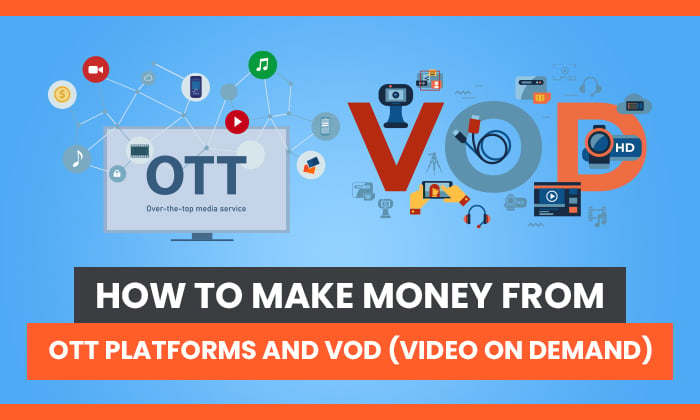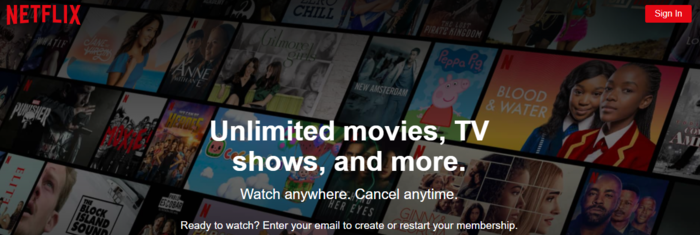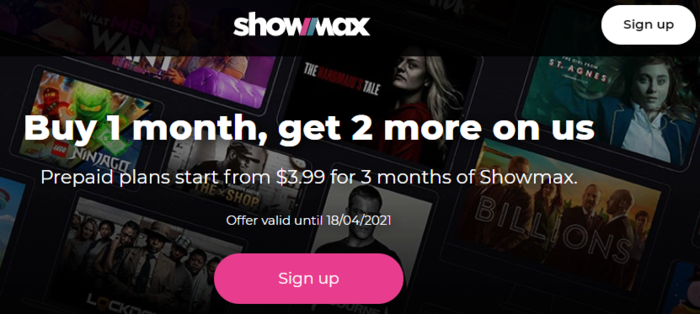
As a business or marketing professional, when consumer habits change, you must pay attention. Perhaps nothing is changing more rapidly or drastically than how people consume video content.
To leverage this shift, you must first understand two of the most common video consumption methods: video on demand (VOD) and over-the-top (OTT). We cover both in this guide.
What Is Video on Demand (VOD)?
Video on demand (VOD) is a technology allowing viewers to watch video content when and where they want and the click of a button or tap on a touchscreen.
VOD is also popular because you can pause, rewind, or fast-forward content—and, unlike DVDs, you can easily start an episode from the moment you stopped it rather than searching through a menu.
In short, it gives viewers complete control of what they consume and how they want to consume it.
One of the most popular VOD services is Netflix, which started as a DVD mailing service and kept ahead of the game by adopting streaming early.

What Is OTT?
Over-the-top (OTT) is a way of streaming video and film content over the internet at the user’s request.
The primary reason for this unusual name, over-the-top, is because it goes over the tops of traditional media distribution channels and distributes content directly to the consumer via an internet connection.
OTT platforms were made popular by streaming services like Amazon Prime Video, Hulu, YouTube, and more.
VOD Vs. OTT—What’s the Difference?
One of the primary differences is the medium through which video content is delivered.
- VOD: Video on demand involves consuming any media content that isn’t played on a certain schedule or requires a physical DVD, tape, etc.
- OTT: This is strictly streamed content, not downloaded or otherwise stored offline, and can include media like videos and online radio programs, such as podcasts.
The other big difference is VOD can’t be live content, while OTT can, as VOD by definition can’t have a set schedule involved. However, live content can later become VOD if it’s allowed to stay online for future viewing.
OTT is often VOD, but not always, and vice versa. As you may have guessed, many platforms, like YouTube, are categorized under both VOD and OTT.
Are VOD and OTT Right for Me?
If you’re willing to put in the hard work to create a high volume of quality on-demand content, you may be wondering if VOD or OTT is right for you. Bearing in mind there is overlap between the two, here are some pros of each option to help you determine which best suits your needs.
Pros of VOD
VOD enables you to deliver on-demand content to users, which is incredibly popular among consumers. As a result, you could monetize your brand faster and easier via VOD.
This method is best suited to subscription-based businesses. For example, fitness coaches can use VOD platforms to offer monthly subscriptions for on-demand fitness classes.
VOD also works well for brands wanting to leverage sponsorship deals—more on these monetization methods in a moment.
However, to make money from VOD, you must have a large, high-quality content library, so make sure you have a team able to handle this workload.
Pros of OTT
OTT’s strength lies in utilizing the internet, resulting in OTT platforms being able to offer both video-on-demand services and live streaming. This is essential for brands that rely on live events in their business model. A good example is Wanderlust TV:

If live events are part of your marketing mix, OTT is the way to go for you and your brand.
How Do I Make Money With VOD and OTT Platforms?
As a marketer, you may be wondering how to use VOD and OTT to bring in revenue. There are several ways you can profit from your video content.
Monetizing OTT Advertising
To get started with OTT advertising, you need:
- The right technology: You can use third-party tools like Google Ads or have a custom solution developed to suit your specific OTT advertising needs.
- An audience: OTT advertising hinges on a large audience as advertisers typically pay on a cost per mille (CPM) basis.
- Data: Data on your audience demographics is essential to helping advertisers decide whether your platform will provide them with a healthy return on advertising spend (ROAS).
You have three options to monetize your OTT platform: video advertising networks, direct advertising, and scholarship deals.
1. Video Advertising Networks
One of the fastest ways to generate revenue from your OTT is to join a video advertising network (VAN). VANs connect you to marketers looking for ad space.
The major drawback to VANs is you lose control of the type of ads appearing on your platform—if something offensive plays, your audience may blame you. However, VANs are convenient as you don’t have to find advertisers on your own, so be sure to fully research any VAN you consider and read the fine print before signing.
2. Direct Advertising
Direct advertising allows you to take control of the kinds of ads you display on your OTT platform. To do this, you must develop a custom ad server to manage the ads you display on your platform.
Going the direct advertising route means you’ll have to find advertisers, negotiate with them directly, and set your rates. It’s a lot of work both on the business and development sides. However, you may get better returns as there’s no middleman.
3. Sponsorship Deals
Just as in the days of television, OTT sponsorship deals involve a brand paying for the right to advertise on a particular piece of content.
There are many ways to deliver your sponsored messaging. For instance, you can weave it into your content, show it as banner ads, or display it on launch screens.
An advantage of sponsorship deals is they can simplify your ad rotation because you only have to serve a few sponsoring brands. However, that can prove costly should any choose to end their sponsorship.
Monetizing VOD
Just like OTT advertising, you have three main options for monetizing VOD content: subscription video on demand (SVOD), transactional video on demand (TVOD), and ad-supported video on demand (AVOD).
1. Subscription Video on Demand (SVOD)
Subscription video on demand (SVOD) is one of the most popular ways of monetizing a VOD platform.
The SVOD model works by getting users to pay a recurring fee to access your content.

SVOD is often one of the most profitable ways of generating a steady flow of income from your platform as long as you have content people are willing to pay for.
Luckily, research shows the estimated revenue and usage of SVOD are expected to continue growing for the foreseeable future.
With SVOD, you can create different access levels at various price points, making your VOD content available to a wider audience.
2. Transactional Video on Demand (TVOD)
Transactional video on demand (TVOD) is a monetization method allowing users to access content on a pay-per-view basis.
You have two main ways to offer TVOD to your customers, namely:
- purchasing permanent access to a piece of content with a one-time payment, like we used to do with DVDs
- renting a piece of content at a lower cost than the purchase but with a limited access period
According to Statista, revenue in the TVOD market is growing and expected to reach $12,150 million by 2025.
With a dollar amount like that, TVOD may be an attractive option.
3. Ad-supported Video on Demand (AVOD)
Another excellent way to monetize your VOD platform is the ad-supported video on demand (AVOD) model.
Unlike SVOD and TVOD, where users pay to view your content, the AVOD model generates revenue solely from advertisers. Your users don’t pay a dime. Because of this, such platforms tend to attract large audiences.
How does this work?
Advertisers pay to place ads in your video streams. Instead of paying to watch your content, viewers see a few ads as they stream your video content. A popular example of this is the free version of YouTube.

The AVOD model gives you two options:
- signing up for video ad networks
- direct advertising
Of course, the more viewers you have, the more likely you are to find advertisers.
What Platforms are Best for VOD and OTT?
Ready to launch your VOD services?
Not so fast.
You need a VOD hosting platform first. With so many of them available, choosing one can be a daunting task. Besides, if you don’t know what you’re doing, you may sign up for a platform that won’t meet your needs.
Here are a few platforms to consider.
1. Uscreen
One of the biggest players in the VOD hosting platform space is Uscreen. The platform is one of the most affordable, enabling even small businesses to use their services. For $49 per month, you get access to marketing tools, video hosting services, pricing control, and more.
2. Dacast
Dacast is a streaming solution offering both VOD and OTT functionality. Best suited for enterprise businesses and professional use, they provide hosting for high-quality video broadcasts and live streaming. A few of their notable features include video monetization, robust security, and API integrations. Plans start as low as $39 per month.
3. IBM Cloud Video
IBM Cloud Video offers an expansive feature set, making it easy to tailor everything to your needs. However, because it has tons of features, it can be challenging to navigate. That makes it best suited for businesses with expert broadcasters on their team. IBM Cloud Video runs at higher price points than the last two options, with their starter plan coming in at $99/month.
Of course, these aren’t the only three out there. In addition to some of the big-name platforms we’ve mentioned, others you can consider include:
Because the industry is growing fast, you can expect new players to come on the scene.
Conclusion
With the right content, audience, and monetization strategies, VOD and OTT content have the potential to grow your revenue significantly.
Are you interested in creating a VOD/OTT strategy but don’t know where to start? If so, can help. Our agency also offers services like email marketing, SEO, content marketing, and paid advertising.
Have you ever used VOD or OTT to generate revenue? If so, what was your experience?
from Blog – Neil Patel https://ift.tt/3rZ9Ymg

No comments:
Post a Comment